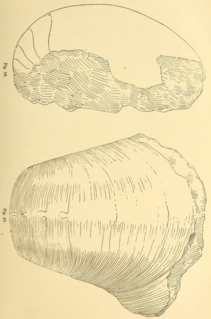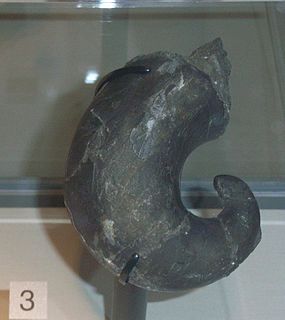Acanthonautilus is an extinct genus in the nautilid family Solenochildae (Aipocerataceae) from the Upper Mississippian of North America and equivalent strata in Europe, first described by Foord in 1896.
Curtoceras is a genus in the tarphycerid family Trocholitidae found widespread in the late Early and Middle Ordovician of North America and northern Europe. Curtoceras has a shell that is gradually expanded, with half the fully mature body chamber divergent from the preceding volution. Whorl sections are near equidimentional with the inner margin (dosum) moderately impressed. The surface may be smooth or weakly ribbed. The siphuncle is ventral in the initial chamber and becomes dorsal after one volution. With the exception of the dorsal siphuncle, Curtoceras is somewhat similar to the tarphyceratid Campbelloceras
The Tarphyceratidae are tightly coiled, evolute Tarphycerida with ventral siphuncles. The dorsum is characteristically impressed where the whorl presses against the venter of the previous. The Tarphyceratidae are derived from Bassleroceras or possibly from some member of the Estonioceratidae.
The Trocholitidae are Tarphycerida with whorls in close contact as with the Tarphyceratidae, but in which the siphuncle, similar in structure, becomes dorsal. The Trocholitidae are derived from the Tarphyceratidae, perhaps from different tarphyceratids.
Tylonautilus is an extinct genus in the nautiloid order Nautilida from the Lower Carboniferous of Europe and Permian of Japan.
Heminautilus is an extinct genus of nautiloids from the nautilacean family Cenoceratidae that lived during the Early Cretaceous. Fossils of Heminautilus have been registered in rocks of Barremian and Aptian age. Nautiloids are a subclass of shelled cephalopods that were once diverse and numerous but are now represented by only a handful of species.
Syringonautilidae is a family of Nautiloidea from the middle to late Triassic. Syringonautilidae comprise the last of the Trigonoceratoidea and are the source for the Nautilaceae which continued the Nautiloidea through the Mesozoic and into the Cenozoic right down to the recent. Syringonautilidae is a strictly Triassic family, derived early in the Triassic from the Grypoceratidae.
Aphelaeceras is an extinct genus from the nautilid family Trigonoceratidae which is part of the Trigonocerataceae, that lived during the Mississippian Period in the late Paleozoic.
Rineceras is an extinct genus from the nautilid family Trigonoceratidae which is part of the Trigonocerataceae, that lived during the Mississippian Period in the late Paleozoic.
Liroceras is a genus of nautiloid cephalopod. It is the type genus of the clydonautiliacean family, Liroceratidae, and is characterized by a rapidly expanding, subglobular, nautiliconic shell with a reniform whorl section, small umbilicus, essentially straight sutures, and a siphuncle with a variable but not marginal position.

Cymatoceras is a wide-ranging extinct genus from the nautilitacean cephalopod family, Cymatoceratidae. They lived from the Late Jurassic to Late Oligocene, roughly from 155 to 23 Ma.
Barrandeoceras is a large, coiled, Middle Ordovician nautiloid cephalopod and part of the Tarphycerida. The shell is serpenticonic with whorls touching but not embracing. The adult body chamber becomes freed of the preceding whorl, a rather common character among tarphyceroids. Whorl section is oval, somewhat more narrowly rounded ventrally, on the outer rim, than dorsally, on the inner rim. Prominent lateral ribs, at least on inner whorls. Grow lines show a distinct hyponomic sinus. Sutures have lateral lobes. The siphuncle is subcentral.
Aethoceras is a genus of Tarphycerida nautiloids included in the family Estonioceratidae for which the shell is a loosely coiled, gradually expanding dextral torticone with a slightly depressed whorl section. Siphuncle small, ventral, submarginal. Whorl section somewhat resembles early stages of Estonioceras in being laterally fanged. Trochoidal coiling brings to mind the later Trocholitidae. Aethoceras was originally found in the lower Ordovician of Western Australia.
Librovitschiceras is a genus of nautilids, in the subclass Nautiloidea, with a triangular cross section, included in the family Aipoceratidae. Its exact relationship with other aipoceratids is uncertain. Whorls are in contact, the siphuncle is slightly removed from the venter, which has a deep sinus.

The Aipoceratidae are a small family of Carboniferous nautilids which have smooth shells and loosely coiled to faintly impressed whorls and in which the aperture may be modified at maturity. The Aipoceratidae include the Lower Carboniferous Aipoceras and Asymptoceras, and Librovitschiceras from the Upper Carboniferous. The Solenochilidae are closely related.

Aipoceras is a genus of loosely coiled aipoceratid nautiloids with laterally compressed whorls; shells expanding moderately to fairly rapidly with a tendency to uncoil at maturity. Juvenile forms are somewhat cyrtoconic. The apical end forms a hook. Aipoceras has been found in Lower Mississippian strata in the U.S.
Homoadelphoceras is a genus of gyroconic rutoceratid Nautiloid from the Middle Devonian of central Europe. Whorls not in contact, venter and dorsum,, broadly rounded. Dorso-lateral and ventro-lateral flanks more or less flat, meet at an angle.
Hindeoceras is a genus of nautilids from the middle Devonian of North America, included in the tainoceratacean family Rutoceratidae.
Callaionautilus is a genus of cephalopods included in the nautilid family Clydonautilidae that lived during the Late Triassic. Its fossils have been found on the island of Timor.
Cosmonautilus is a genus of cephalopods included in the nautilid family Clydonautilidae. Its shell is involute, with only the outer whorl exposed. Early whorls are with nodes on ventral shoulder, which disappear on the later growth staged. Later whorls are smooth.



